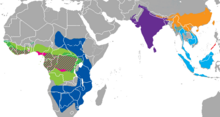Smutsia
| African ground pangolin | |
|---|---|

| |
| Pangolins from genus Smutsia | |
| Scientific classification | |
| Kingdom: | Animalia |
| Phylum: | Chordata |
| Class: | Mammalia |
| Order: | Pholidota |
| Family: | Manidae |
| Subfamily: | Smutsiinae Gray, 1873 |
| Genus: | Smutsia Gray, 1865 |
| Type species | |
| Smutsia gigantea Illiger, 1815
| |
| Species | |

| |
| Synonyms | |
|
synonyms of subfamily:
| |
Smutsia is a genus of African pangolins, better known as the African ground pangolins, from subfamily Smutsiinae, within family Manidae. It was formerly considered a subgenus of Manis.[2] Its members are the more terrestrial of the African pangolins.[3]
Etymology[]
British naturalist John Edward Gray named Smutsia for South African naturalist (1808–1869),[4][5] the first South African to write a treatise on mammals in 1832 (in which he described the species Manis temminckii).
Taxonomy[]
- Subfamily: Smutsiinae (large African pangolins)
- Genus: Smutsia (African ground pangolin)
- Smutsia gigantea (giant pangolin)
- Smutsia temminckii (ground pangolin)
- †[6]
- Genus: Smutsia (African ground pangolin)
Phylogeny[]
Phylogenetic position of genus Smutsia within family Manidae[7][8][1]
| Pholidotamorpha |
| ||||||||||||||||||||||||||||||||||||||||||||||||||||||||||||||||||
(Pholidota sensu lato)
|
References[]
- ^ a b Philippe Gaubert, Agostinho Antunes, Hao Meng, Lin Miao, Stéphane Peigné, Fabienne Justy, Flobert Njiokou, Sylvain Dufour, Emmanuel Danquah, Jayanthi Alahakoon, Erik Verheyen, William T Stanley, Stephen J O’Brien, Warren E Johnson, Shu-Jin Luo (2018) "The Complete Phylogeny of Pangolins: Scaling Up Resources for the Molecular Tracing of the Most Trafficked Mammals on Earth" Journal of Heredity, Volume 109, Issue 4, Pages 347–359
- ^ Schlitter, D.A. (2005). "Order Pholidota". In Wilson, D.E.; Reeder, D.M (eds.). Mammal Species of the World: A Taxonomic and Geographic Reference (3rd ed.). Johns Hopkins University Press. pp. 530–531. ISBN 978-0-8018-8221-0. OCLC 62265494.
- ^ du Toit, Z.; du Plessis, M.; Dalton, D. L.; Jansen, R.; Paul Grobler, J.; Kotzé, A. (2017). "Mitochondrial genomes of African pangolins and insights into evolutionary patterns and phylogeny of the family Manidae". BMC Genomics. 18 (1): 746. doi:10.1186/s12864-017-4140-5. PMC 5609056. PMID 28934931.
- ^ "S2A3 Biographical Database of Southern African Science [Johannes Smuts]". Retrieved May 28, 2018.
- ^ Palmer, T.S. (1904). "Index Generum Mammalium: a List of the Genera and Families of Mammals". North American Fauna. 23: 635. doi:10.3996/nafa.23.0001.
- ^ Terhune, C. E.; Gaudin, T.; Curran, S.; Petculescu, A. (2021). "The youngest pangolin (Mammalia, Pholidota) from Europe". Journal of Vertebrate Paleontology. in press: e1990075. doi:10.1080/02724634.2021.1990075.
- ^ Gaudin, Timothy (2009). "The Phylogeny of Living and Extinct Pangolins (Mammalia, Pholidota) and Associated Taxa: A Morphology Based Analysis" (PDF). Journal of Mammalian Evolution. Heidelberg, Germany: Springer Science+Business Media. 16 (4): 235–305. doi:10.1007/s10914-009-9119-9. S2CID 1773698.
- ^ Kondrashov, Peter; Agadjanian, Alexandre K. (2012). "A nearly complete skeleton of Ernanodon (Mammalia, Palaeanodonta) from Mongolia: morphofunctional analysis". Journal of Vertebrate Paleontology. 32 (5): 983–1001. doi:10.1080/02724634.2012.694319. ISSN 0272-4634. S2CID 86059673.
Categories:
- Smutsia
- Mammal genera
- Mammals of Sub-Saharan Africa
- Taxa described in 1865
- Taxa named by John Edward Gray
- Mammal stubs




